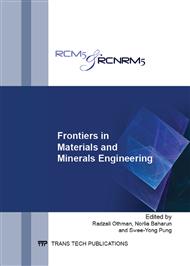p.24
p.32
p.40
p.46
p.52
p.56
p.60
p.67
p.74
Effect of Solid Concentration on Properties of Porous Alumina
Abstract:
In this study, porous alumina was fabricated by using polymeric sponge method. The slurries were prepared by mixing alumina (Al2O3) and polyvinyl alcohol (PVA) powder in distilled water. Slurries with two different compositions (60 and 70 wt. %.) of solid concentration were prepared. Samples were dried in an oven at 80 °C for 24 hours and sintered at temperature of 1500 °C. The effect of solids concentration was studied. Characterizations such as density and porosity tests, compressive strength as well as microstructure morphology were then used to analyze the sintered porous alumina samples. Specimens with 60 wt. % of solid loadings showed the higher porosity (88.06%) and pores structure more clearly interconnected. However, specimens with higher strength, 0.55 MPa, were obtained by using slurry with solid loadings of 70 wt. %.
Info:
Periodical:
Pages:
52-55
Citation:
Online since:
November 2013
Price:
Сopyright:
© 2014 Trans Tech Publications Ltd. All Rights Reserved
Share:
Citation:


